Physical Address
304 North Cardinal St.
Dorchester Center, MA 02124
The liver’s amazing capacity to regenerate is unique in the human body and has captivated mankind since ancient civilizations, as in the Greek myths of the giant villain Tityus and the heroic Titan Prometheus (see Introduction). Twenty-seven centuries later, physicians have achieved the ability to use and manipulate such regenerative capacity, not to torture as it was lucubrated in the past, but to treat and eventually cure oncologic liver diseases (see Chapter 6 ). The most recent surgical innovation to catalyze an accelerated liver hypertrophy, which has motivated debates among liver surgeons for the last decade, is now widely known by the acronym ALPPS ( A ssociating L iver P artition and P ortal vein ligation for S taged hepatectomy) (see Chapter 102D ). This technique is basically a two-stage strategy to induce rapid and massive future liver remnant (FLR) hypertrophy, thus reducing the usual time interval between stages to 1 or 2 weeks, and allowing resection of liver tumors otherwise functionally irresectable ( Fig. 123.1 ).
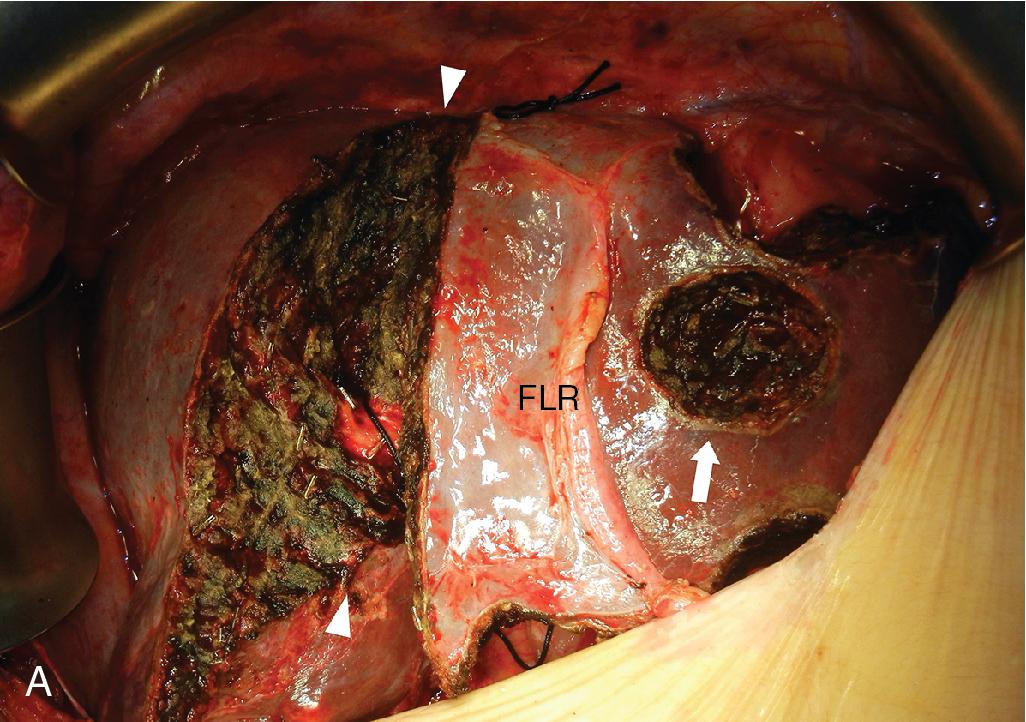
The first ALPPS was performed somewhat incidentally by Prof. Hans J. Schlitt from Regensburg, Germany, in September 2007. The scenario occurred in a 49-year-old female patient with hilar cholangiocarcinoma scheduled for a right trisectionectomy. The original procedure consisted of a right portal vein (PV) transection combined with simultaneous complete in situ splitting of the liver along the falciform ligament. The middle hepatic vein (MHV) was taken down but the hepatic artery (HA) still was untouched both to the right and to the left side. Having completely transected the liver, the FLR seemed to be critical and not sufficient for adequate postoperative liver function. Therefore the plan for resection was canceled at this point of the operation. Instead, after dividing the left hepatic duct at the basis of the umbilical fissure a Roux-en-Y hepaticojejunostomy to the left lateral lobe was performed to decompress the biliary tree of segments II and III. The central stump of the left hepatic duct was closed and the operation stopped without removing the tumor. A computed tomography (CT) scan performed 1 week later showed an almost doubling in volume of segments II and III assigned to be the FLR. Hence the decision to return to the operating room was made, and trisectionectomy plus resection of the hilar bifurcation was completed on day 9 after the initial surgery. Postoperative course was uneventful without any signs of liver insufficiency, but the patient developed early tumor relapse. A similar technique—with minor modifications—was then applied in two subsequent patients with colorectal liver metastases (CRLM) and intrahepatic cholangiocarcinoma (ICC). This new approach, originally termed in situ-split liver resection. was soon adopted by other hepato-pancreato-biliary (HPB) centers in Germany. In 2011, at the 9th congress of the European-African Hepato-Pancreato-Biliary Association (E-AHPBA) in Capetown, South Africa, a first report of 5 cases (in the abstract of 3 cases) was presented by the group from Mainz, Germany. One year later, and 5 years after the pioneering operation, a multicenter inaugural report with 25 “in situ-split liver resections” from 5 German HPB groups in Regensburg, Mainz, Göttingen, Gieβen, and Tübingen was published in Annals of Surgery. In this paper, a 74% FLR hypertrophy after a median of 9 days and a 100% resection rate were reported in otherwise irresectable tumors due to a too-small FLR. As the term in situ-split was already used for the partition of the liver in segmental liver transplantation, Eduardo de Santibañes and Pierre Clavien suggested that this new procedure be termed ALPPS (for A ssociating L iver P artition and P ortal vein ligation for S taged hepatectomy). The increasing interest in the ALPPS concept and the great passion involved in its development prompted the creation of the International ALPPS Registry in 2012 (founding members P. A. Clavien, H. Lang, and E. de Santibañes) to collect data on this new procedure from centers all over the world ( https://www.ALPPS.net ).
This innovative technique, which pushed the limits of resection in a dimension that had never been thought to be possible before, led to an almost euphoric wave among HPB surgeons worldwide. With the introduction of ALPPS as a modification of standard two-stage hepatectomy (TSH), a breakthrough in hepatic surgery seemed to be reached allowing an almost 100% resection rate in tumors otherwise considered irresectable due to an insufficient FLR volume ( Fig. 123.2 ; see Chapter 102D ). In selected cases, median hypertrophy rates of 160% and up to 250% were reported, permitting even the resection of all but one liver segment, the so-called monosegment ALPPS. This important finding even challenged one of the basic rules in liver surgery, as functional resectability is traditionally supposed to require the preservation of at least two contiguous Couinaud’s segments with intact vascular inflow, outflow, and biliary drainage. However, the initial hype surrounding this new technique soon slowed down in the face of a very high initial perioperative surgical risk (12% mortality in the inaugural multicenter German experience), and some opinion leaders in HPB surgery raised concerns claiming that the increase in resectability in ALPPS was bought at the expense of a loss of safety. , After analyzing initial data from the ALPPS Registry, it was found that the vast majority of deaths occurred after stage 2 and that posthepatectomy liver failure (PHLF) was paradoxically the main cause of poor outcomes, even when theoretically sufficient FLR volumes had been achieved. , At the same time reports from Belgium, France, and Italy demonstrated that post–stage 1 complications grade ≥3b (according to Clavien/Dindo) were significant predictors of post–stage 2 mortality. , Potential risk factors for an unfavorable outcome were in particular post–stage 1 biliary fistula or infected and/or bilious peritoneal fluid at stage 2. In particular, pre–stage 2 bilirubin and creatinine levels were found to be determinants for the outcome after ALPPS. , In the following years, with better knowledge of these risk factors and a rising learning curve, several improvements of the classic ALPPS technique evolved. The modifications addressed anatomic and diagnostic aspects as well as the surgical technique itself. Anatomically, special attention was paid to the vascularization and biliary drainage of segment IV (see Chapter 2 ) in order to avoid ischemia/necrosis or bile leakage. Further on, the importance of the venous drainage of segment IV became evident. The concept of preserving the MHV during stage 1 finally led to the development of “partial ALPPS” through incomplete parenchymal transection, which was soon associated with better perioperative outcomes and equivalent FLR hypertrophy. , One of the most promising ALPPS innovations aiming to reduce the trauma during stage 1 was to avoid surgical manipulation of the hepatic hilum by replacing surgical portal vein ligation (PVL) by portal vein embolization (PVE; see Chapter 102C ), also known as “hybrid ALPPS.” More recently, the combination of partial parenchymal transection and simultaneous intraoperative PVE was named “mini ALPPS.” With the introduction of mini ALPPS, not only a modification of the ALPPS procedure but an entire change of paradigm was accomplished. In contrast to classic ALPPS, the surgical extent and the associated trauma of stage 1 were dramatically reduced, and the main surgical steps were performed during the stage 2 operation. Only shortly after the introduction of ALPPS, the first reports on minimally invasive approaches also appeared (see Chapter 127 ). , Initial results were encouraging, and the aforementioned technical variations for the open procedure such as partial or mini ALPPS were also applied successfully in the laparoscopic setting. In 2016 the first case reports on robotic ALPPS appeared. Technically, the robotic approach is feasible but needs further evaluation. All these technical refinements and a better patient selection led to a stepwise reduction of overall perioperative morbidity and mortality rates of ALPPS ( Fig. 123.3 ). ,
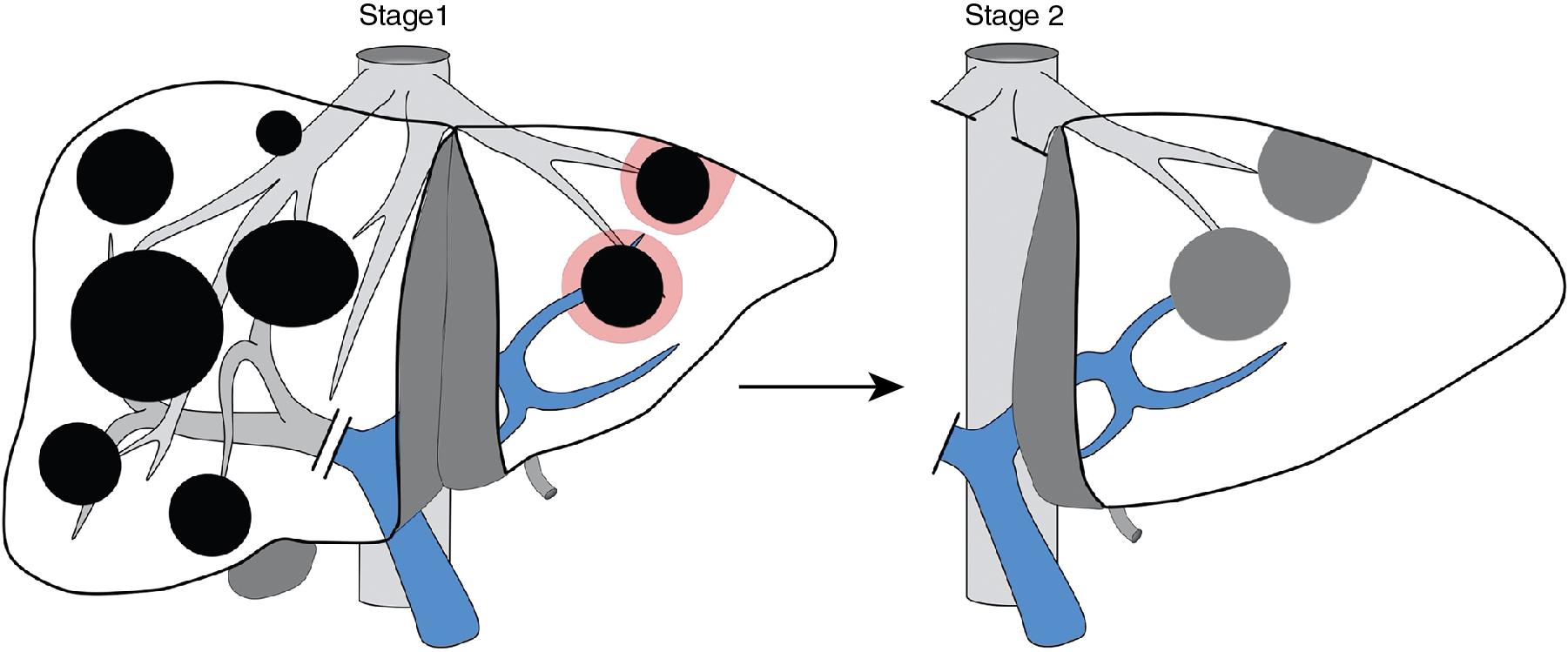
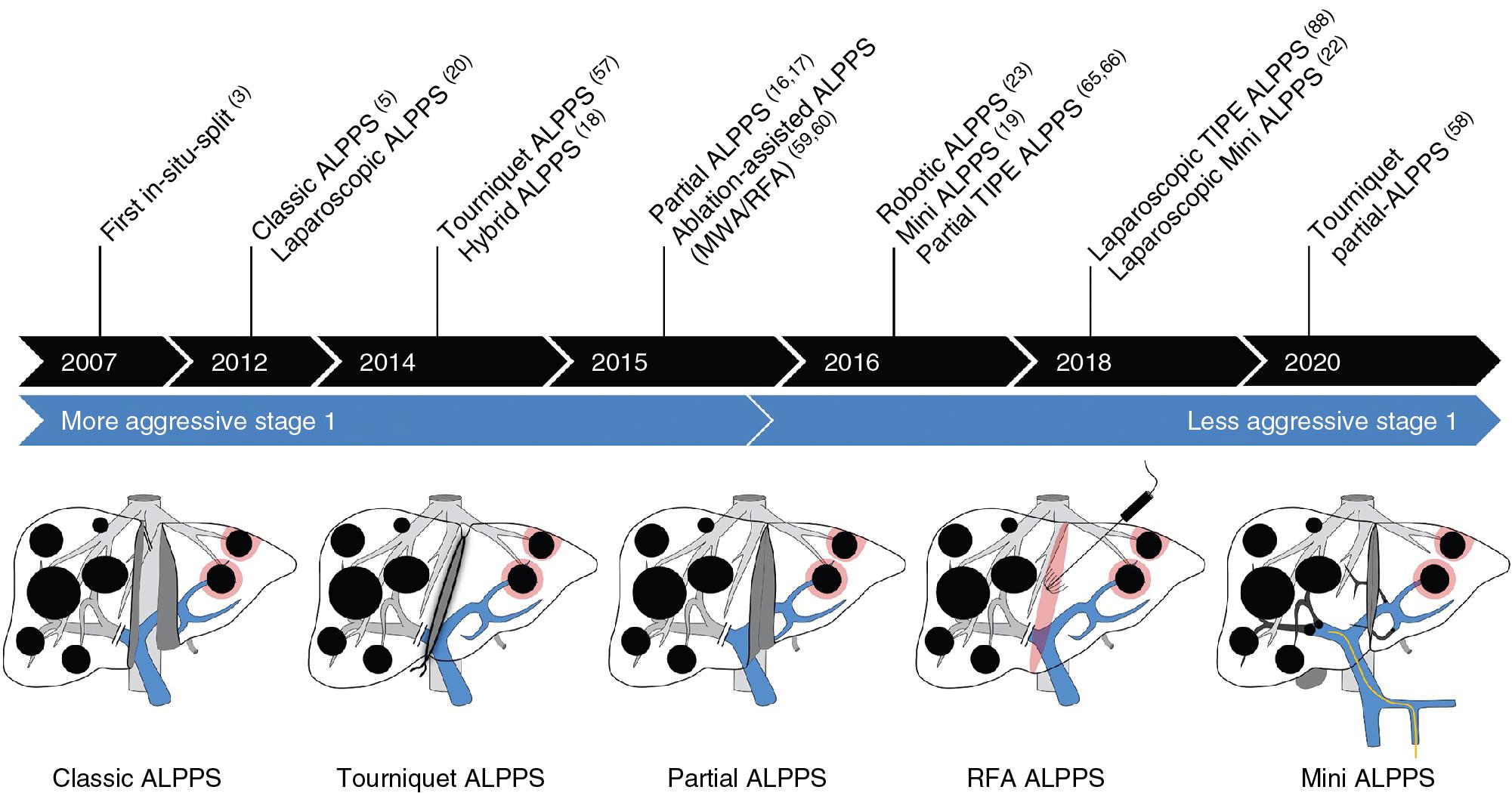
So far, ALPPS has become a feasible and safe strategy in experienced hands and well-selected candidates, representing a promising option to be included in the multidisciplinary armamentarium to increase resectability in patients with locally advanced liver tumors, especially those suffering from colorectal liver metastases (see Chapters 101 and 102D ). Current evidence seems to indicate that this novel short-interval staged hepatectomy has arrived to stay, with the celebration of the “first consensus meeting” in 2015, a “10th anniversary” meeting in 2017, and over 1250 patients currently enrolled in the ALPPS International Registry ( https://www.ALPPS.net ).
The main components of ALPPS, no matter which technique or modification is used, are the following: (1) the interruption of PV circulation, (2) the manipulation of the liver parenchyma along the transection line, and (3) the two stages of the operation. The ALPPS concept is based on a complete portal venous devascularization of the tumor-carrying liver but with preservation of the arterial blood flow as well as an intact vascularization including biliary drainage of the FLR. Consequently, precise anatomic knowledge is crucial (see Chapter 2 ). , Due to the high proportion of vasculobiliary variants, preoperative imaging is mandatory to assess not only the FLR, but all individual anatomic details (see Chapters 4 and 13 ). This is quite important, particularly when tumor structures alter normal anatomy, a situation frequently encountered when treating patients with advanced liver tumors.
At stage 1, the preservation of arterial inflow to both sides, future remnant and specimen, is crucial. Lesions to the HA or occlusion may cause necrosis and failure of the procedure. The most common arterial variants are a replaced or accessory right and/or left arteries (see Chapter 2 ). In right trisectionectomy, at stage 1 operation, special attention has to be paid to the “middle HA” and to branches supplying segment IV ( Fig. 123.4 ). The middle HA runs extrahepatically in about two-thirds of cases, originating from either the right or the left HA. In about one-third of cases the middle HA comes from the left HA in the umbilical fissure. The preservation of the perfusion to segment IV is imperative in ALPPS stage 1 to avoid ischemic complications.

The interruption of specimen-side portal inflow is a key of the ALPPS procedure. PV anatomic variants mainly refer to the right side (see Chapter 2 ). , It is useful to distinguish a single PV branching or trifurcation from truly abnormal configurations ( Fig. 123.5 ). Missing and not interrupting a portal branch during ALPPS stage 1 can occur in trifurcation, but is more likely in true aberrant branches, for example, a right anterior sectorial portal branch from the left branch (type C and particularly type D intraparenchymal branching; according to Nakamura). On the left side there is a relatively constant number of portal branches to segments II and III (usually one single branch to segment II and either a single, double, or triple branch to segment III) and a variable number (up to 5–9) of branches to segment IVa and IVb.
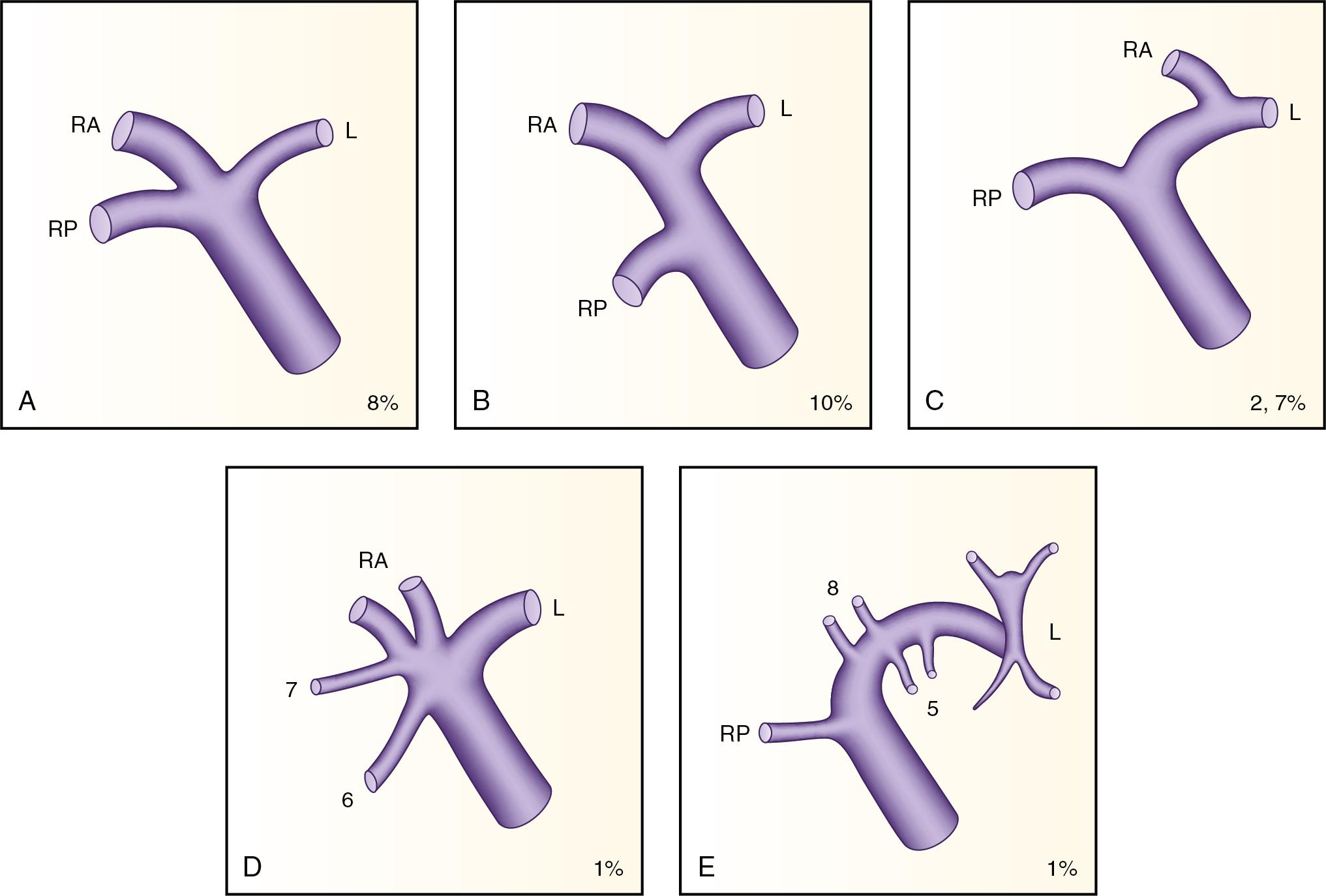
The venous drainage runs via the right, middle, and left hepatic veins (HVs), with the middle and left forming a common trunk in about 90% of the cases before entering the vena cava. , A typical variation of the right side is the presence of an inferior right hepatic vein (IRHV) draining segment VI, which usually is much smaller than the right hepatic vein (RHV) but occasionally may have the same or an even larger size (see Chapter 2 ).
The MHV may show tremendous variations in size and also draining areas. Regularly, the MHV drains about 20% to 30% of total liver volume, mainly parts of segment IVa and IVb and segments V and VIII. A dominant MHV may drain up to 50% of the liver with contributions also from segment VI, and rarely from segment III. In ALPPS for right trisectionectomy, preservation of the MHV outflow at stage 1 may be crucial, in particular in case of a dominant MHV.
The venous drainage of the left lateral segments is quite constant with a common stem of the segment II and III veins as left hepatic vein (LHV). The rare case of a segment III HV draining into the MHV must be considered. This potentially risky constellation requires the preservation of the proximal MHV in continuity with the aberrant HV at stage 2. Special attention has to be paid also to an intersectional vein running in line with the falciform ligament. This vein usually empties into the LHV but rarely it may enter the MHV.
The biliary tree shows multiple variations with regard to division and course of bile ducts (BDs) ( Fig. 123.6 ). , A precise knowledge of bile duct anatomy (see Chapter 2 ) is of utmost importance as biliary complications are a major source for postoperative morbidity and mortality in ALPPS. , Anatomic variations of the left biliary system usually refer to distribution and localization of segmental BDs. A single left hepatic duct is present in 98% of cases ( Fig. 123.7 ). In about two-thirds of cases a segment IV BD separate from segment II/III ducts is present. In about one-fourth of cases there is a common segment IV and III and a separate segment II BD, and much less frequently a common segment II and IV BD and a separate segment III duct. Of special relevance are crossing right BDs. A right-posterior BD entering the left hepatic duct is present in about 5% of cases, and a right anterior draining in the left system in only 1%. Even more rare, left hepatic ducts (either segment II or IV ducts or both) cross to the right side.
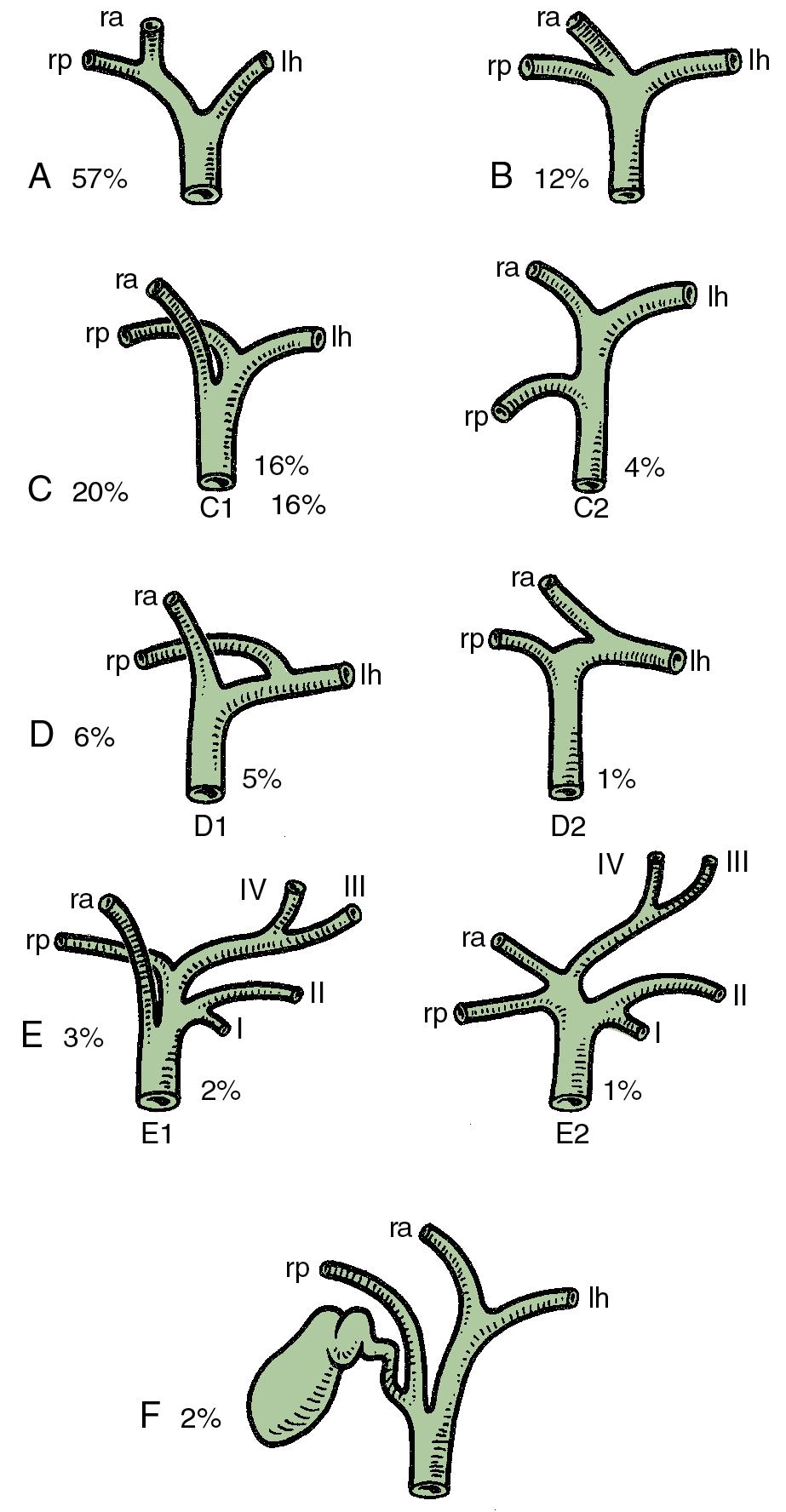
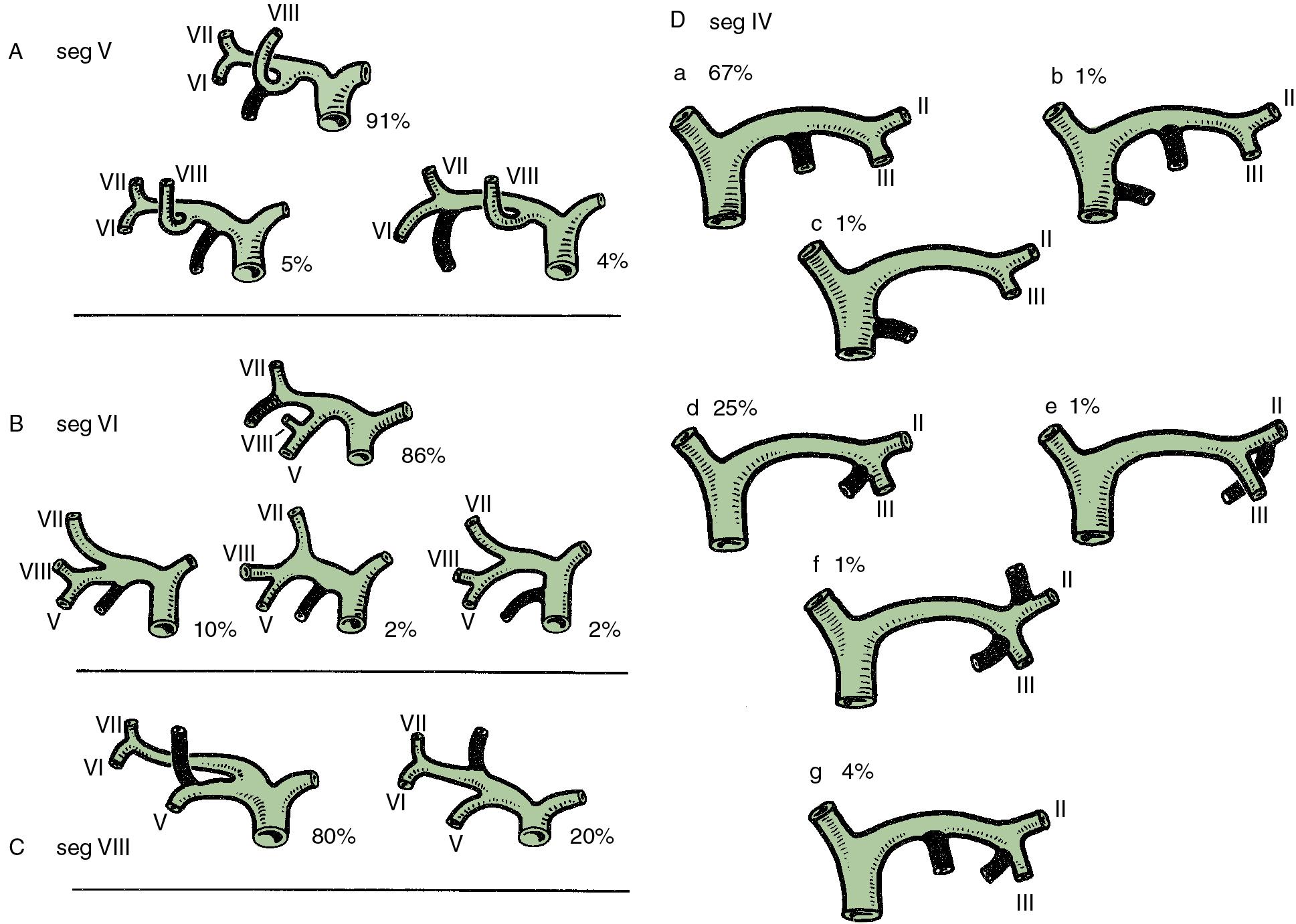
Become a Clinical Tree membership for Full access and enjoy Unlimited articles
If you are a member. Log in here